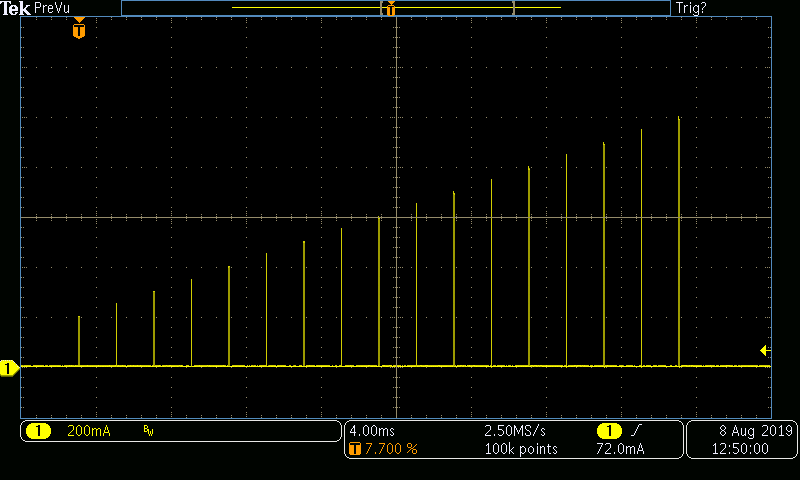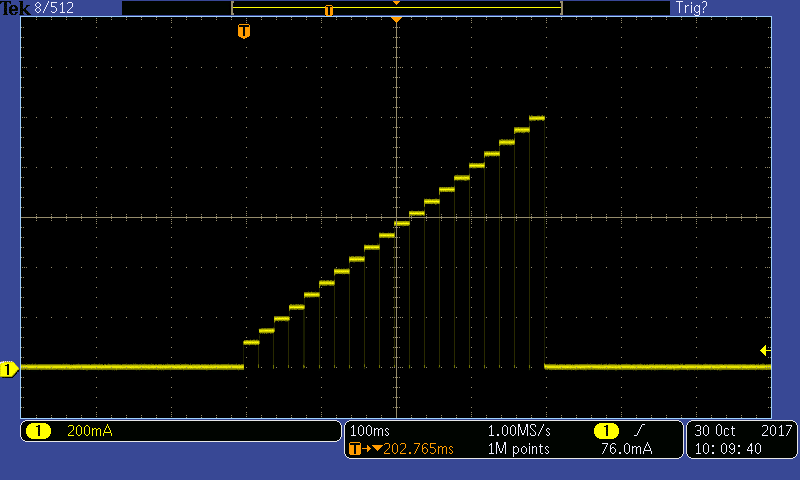Staircase current sweeps are a traditional method for generating I-V, V-I, or LIV curves. Staircase current sweeps have been the de-facto standard for generating IV curves but, there are better methods available with VEKTREX’s next generation pulsed source measure unit (SMU). Vektrex pulsed SMU current sweep capabilities include pulsed current sweeps and burst pulsed current sweeps.

Using the SpikeSafe SMU for Staircase Current Sweeps
Measurement standards recommend using hardware triggers with language like: “Triggers used to coordinate the precision pulsed current source, the spectrometer, and the digitizer shall be hardware-based to minimize timing variation.” Vektrex SMU hardware-based timing precisely aligns voltmeter or spectrometer measurements to the current steps. This precision alignment means current sweep plots are perfectly repeatable without the variations seen with source-measure instruments that utilize firmware or software-based timing systems.
Several different current sweep modes are available with Source Measure Units.and SpikeSafe Performance Series Current Sources.
Pulsed Current Sweeps
SpikeSafe Performance Series Current Sources and Source Measure Units offer pulsed current sweeps. Leveraging Vektrex’s repeatable, near-perfect, square pulse capability, pulsed current sweeps are easily generated using a series of Single Pulse commands. With pulsed sweeps, the current amplitude is increased in steps and voltage or other measurements are made at each step. With pulsed sweeps, device heating is reduced, and cumulative heating may be avoided. With pulsed sweeps, high power devices may be tested without the need for active cooling.

Hardware-Integrated Pulsed Current Sweep
Unlike the Pulsed Sweep method where individual pulse commands must be programmed, Vektrex SMU offers the hardware-integrated pulsed sweep function. Hardware-integrated Pulsed Sweeps execute faster than traditional staircase sweeps and greatly reduce device heating allowing high-power devices to be tested without the need for active cooling. Hardware integrated pulsed current sweeps simplify pulsed sweep programming. With Vektrex hardware integrated pulsed current sweep, only only one software command is used to define the pulsed sweep parameters and another to start the sweep.
With other instruments, many operator actions or commands are needed to generate one pulsed sweep that may not be repeatable due to software timing.
The hardware integrated pulsed current sweep eliminates delays and uncertainty associated with other instruments which require multiple commands to be sent thus relying on software timing. Relying on software timing increases uncertainty inserting some error into the sweeps.

SpikeSafe SMU hardware integrated sweeps are easy to produce, reliable and repeatable.
Short Pulses Reduce Heating, Improving Accuracy
Use the hardware-integrated pulsed sweep with short pulse on time for the most accurate IV curves during characterization and other testing. A good rule of thumb is to use 20µs pulses at currents above 10% of maximum and 200µs pulses for currents below 10% of maximum. Use an off time that gives a 1-2% duty cycle.
Utilizing Pulsed Sweeps instead of the typical staircase sweeps found in source-measure instruments greatly reduces device junction heating during testing. This means high-power devices may be tested without using active cooling. It also means plots generated with Pulsed Sweeps show reduced droop at high currents, meaning a more accurate plot overall.


What are Staircase Current Sweeps?
A staircase current sweep is a multi-step test in which the current increases by a defined amount for each step time. When current vs time is viewed on an oscilloscope, the waveform looks like a staircase in a building, thus the name. Staircase current sweeps are widely used to test electronic components such as LEDs and lasers, however they have a significant drawback: since the current is always flowing through the device under test (DUT), heating is significant. Often the internal DUT temperature at the last step is many degrees above the first-step temperature. If the parameter being tested (e.g. voltage, wavelength, or optical power) is sensitive to temperature, the data generated using a staircase sweep may be invalid.
Staircase Current Sweep
Staircase current sweeps, also known as Integrated Pulsed Sweeps, are a traditional method for generating an I-V plot. In a staircase sweep, the current level is increased in steps.

While Pulsed current Sweeps more accurately show device characteristics, sometimes it is necessary to duplicate measurements made with previous-generation source-measure instruments that employ non-pulsed or “staircase” sweeps. Staircase sweeps induce significant junction heating, so the measurements made will not perfectly match a typical pulsed sweep measurement. Emulating a staircase sweep with the SpikeSafe SMU is easy. There are three modes available.
A) Pulsed Sweep can be used to approximate a staircase sweep. If the off time is short compared with the on time, then device heating is similar to the heating of a staircase sweep. This is the mode Vektrex recommends to replicate these measurements, the SpikeSafe’s pulsed sweep may be programmed with long on times and very short off times. The resulting waveform duplicates staircase sweep junction heating, enabling direct comparison of old and new measurements.
B) DC Dynamic mode may be used with an external software program that sweeps the current in steps. This method can support and arbitrary number of steps, but timing accuracy depends on software delays that are not always predictable.
C) Modulated DC mode may be used. In this case a sequence is programmed to step the current from minimum to maximum. Up to 20 steps can be programmed.20ms on, 300us off 20 points 0.1 to 1A
Optimize Sweep Speed Using Sweep with Bias Mode
The industry’s first Pulsed Sweep with Bias current mode combines a Pulsed Sweep with a DC bias current. Pulsed Sweep with Bias allows junction temperature (Tj) and forward voltage (Vf) to be measured after each pulse, producing invaluable data and graphs that reduce time to market for devices.
The bias current keeps the semiconductor junction forward biased between pulses so that its forward voltage may be measured. Changes in this voltage correspond to changes in temperature. Plots of this post-pulse forward voltage are easily generated and viewed using the SpikeSafe Control Panel software application.
Simplify Pulse Withstand Testing with Failure Level Capture
Current sweeps may be used for destructive testing or current-limit testing. For example, an LED’s pulse withstand capability may be tested using a pulsed sweep that extends above the device’s absolute maximum pulsed current. This type of testing is supported in two ways – by allowing higher output and capturing the actual current level at the moment of failure and report this current level via a SCPI error message.
Contact us to request a quote and more information about VEKTREX SMU and current sweep modes.